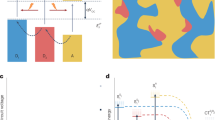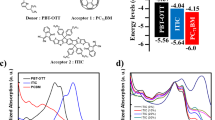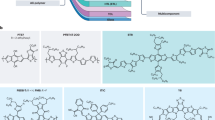Abstract
In the past few years, ternary organic solar cells (OSCs) featuring multiple donor or acceptor materials in the active layer have emerged as a promising structure to simultaneously improve all solar cell parameters compared with traditional binary OSCs. Power conversion efficiencies around 10% have been achieved for conjugated polymers in a ternary structure, showing the great potential of ternary systems. In this review, we summarize progress in developing ternary OSCs and discuss many of the designs, chemistries and mechanisms that have been investigated. We conclude by highlighting the challenges and future directions for further development in the field of ternary blend OSCs.
This is a preview of subscription content, access via your institution
Access options
Subscribe to this journal
Receive 12 print issues and online access
$209.00 per year
only $17.42 per issue
Buy this article
- Purchase on Springer Link
- Instant access to full article PDF
Prices may be subject to local taxes which are calculated during checkout





Similar content being viewed by others
References
Günes, S., Neugebauer, H. & Sariciftci, N. S. Conjugated Polymer-Based Organic Solar Cells. Chem. Rev. 107, 1324–1338 (2007).
Li, G., Zhu, R. & Yang, Y. Polymer solar cells. Nature Photon. 6, 153–161 (2012).
Forrest, S. R. The path to ubiquitous and low-cost organic electronic appliances on plastic. Nature 428, 911–918 (2004).
He, Z. et al. Single-junction polymer solar cells with high efficiency and photovoltage. Nature Photon. 9, 174–179 (2015).
Liu, Y. et al. Aggregation and morphology control enables multiple cases of high-efficiency polymer solar cells. Nature Commun. 5, 5293 (2014).
Kan, B. et al. A series of simple oligomer-like small molecules based on oligothiophenes for solution-processed solar cells with high efficiency. J. Am. Chem. Soc. 137, 3886–3893 (2015).
Tang, C. W. Two-layer organic photovoltaic cell. Appl. Phys. Lett. 48, 183–185, (1986).
Sariciftci, N. S., Smilowitz, L., Heeger, A. J. & Wudl, F. Photoinduced electron transfer from a conducting polymer to buckminsterfullerene. Science 258, 1474–1476 (1992).
Sariciftci, N. S., Smilowitz, L., Heeger, A. J. & Wudl, F. Semiconducting polymers (as donors) and buckminsterfullerene (as acceptor): photoinduced electron transfer and heterojunction devices. Synth. Met. 59, 333–352 (1993).
Yu, G., Gao, J., Hummelen, J. C., Wudl, F. & Heeger, A. J. Polymer photovoltaic cells-enhanced efficiencies via a network of internal donor-acceptor heterojunctions. Science 270, 1789–1791 (1995).
Halls, J. J. M. et al. Efficient photodiodes from interpenetrating polymer networks. Nature 376, 498–500 (1995).
Collins, B. A., Tumbleston, J. R. & Ade, H. Miscibility, crystallinity, and phase development in P3HT/PCBM solar cells: toward an enlightened understanding of device morphology and stability. J. Phys. Chem. Lett. 2, 3135–3145 (2011).
Peet, J. et al. Efficiency enhancement in low-bandgap polymer solar cells by processing with alkane dithiols. Nature Mater. 6, 497–500 (2007).
Lee, J. K. et al. Processing additives for improved efficiency from bulk heterojunction solar cells. J. Am. Chem. Soc. 130, 3619–3623 (2008).
Li, G. et al. High-efficiency solution processable polymer photovoltaic cells by self-organization of polymer blends. Nature Mater. 4, 864–868 (2005).
Svensson, M. et al. High-performance polymer solar cells of an alternating polyfluorene copolymer and a fullerene derivative. Adv. Mater. 15, 988–991 (2003).
Cabanetos, C. et al. Linear side chains in benzo[1, 2-b:4, 5-b′]dithiophene–thieno[3, 4-c]pyrrole-4, 6-dione polymers direct self-assembly and solar cell performance. J. Am. Chem. Soc. 135, 4656–4659 (2013).
Price, S. C., Stuart, A. C., Yang, L., Zhou, H. & You, W. Fluorine substituted conjugated polymer of medium band gap yields 7% efficiency in polymer−fullerene solar cells. J. Am. Chem. Soc. 133, 4625–4631 (2011).
Zhou, H., Yang, L., Price, S. C., Knight, K. J. & You, W. Enhanced photovoltaic performance of low-bandgap polymers with deep LUMO levels. Angew. Chem. Int. Ed. 49, 7992–7995 (2010).
Guo, X. et al. Polymer solar cells with enhanced fill factors. Nature Photon. 7, 825–833 (2013).
Liang, Y. et al. For the bright future — bulk heterojunction polymer solar cells with power conversion efficiency of 7.4%. Adv. Mater. 22, E135–E138 (2010).
Liang, Y. et al. Development of new semiconducting polymers for high performance solar cells. J. Am. Chem. Soc. 131, 56–57 (2008).
Liang, Y. et al. Highly efficient solar cell polymers developed via fine-tuning of structural and electronic properties. J. Am. Chem. Soc. 131, 7792–7799 (2009).
Lu, L., Xu, T., Jung, I. H. & Yu, L. Match the interfacial energy levels between hole transport layer and donor polymer to achieve high solar cell performance. J. Phys. Chem. C 118, 22834–22839 (2014).
Sun, Y. et al. Efficient, air-stable bulk heterojunction polymer solar cells using MoOx as the anode interfacial layer. Adv. Mater. 23, 2226–2230 (2011).
Irwin, M. D., Buchholz, D. B., Hains, A. W., Chang, R. P. H. & Marks, T. J. p-type semiconducting nickel oxide as an efficiency-enhancing anode interfacial layer in polymer bulk-heterojunction solar cells. Proc. Natl Acad. Sci. USA 105, 2783–2787 (2008).
Sun, Y., Seo, J. H., Takacs, C. J., Seifter, J. & Heeger, A. J. Inverted polymer solar cells integrated with a low-temperature-annealed sol-gel-derived ZnO film as an electron transport layer. Adv. Mater. 23, 1679–1683 (2011).
You, J. et al. Metal oxide nanoparticles as an electron-transport layer in high-performance and stable inverted polymer solar cells. Adv. Mater. 24, 5267–5272 (2012).
Jasieniak, J. J., Seifter, J., Jo, J., Mates, T. & Heeger, A. J. A solution-processed MoOx anode interlayer for use within organic photovoltaic devices. Adv. Funct. Mater. 22, 2594–2605 (2012).
Choi, H. et al. Versatile surface plasmon resonance of carbon-dot-supported silver nanoparticles in polymer optoelectronic devices. Nature Photon. 7, 732–738 (2013).
Lu, L., Luo, Z., Xu, T. & Yu, L. Cooperative plasmonic effect of Ag and Au nanoparticles on enhancing performance of polymer solar cells. Nano Lett. 13, 59–64 (2013).
You, J., Dou, L., Hong, Z., Li, G. & Yang, Y. Recent trends in polymer tandem solar cells research. Prog. Polym. Sci. 38, 1909–1928 (2013).
Lu, L., Xu, T., Chen, W., Landry, E. S. & Yu, L. Ternary blend polymer solar cells with enhanced power conversion efficiency. Nature Photon. 8, 716–722 (2014).
Zhang, Y. et al. Synergistic effect of polymer and small molecules for high-performance ternary organic solar cells. Adv. Mater. 27, 1071–1076 (2015).
Cheng, P., Li, Y. & Zhan, X. Efficient ternary blend polymer solar cells with indene-C60 bisadduct as an electron-cascade acceptor. Energy Environ. Sci. 7, 2005–2011 (2014).
Honda, S., Nogami, T., Ohkita, H., Benten, H. & Ito, S. Improvement of the light-harvesting efficiency in polymer/fullerene bulk heterojunction solar cells by interfacial dye modification. ACS Appl. Mater. Interfaces 1, 804–810 (2009).
Itskos, G. et al. Optical properties of organic semiconductor blends with near-infrared quantum-dot sensitizers for light harvesting applications. Adv. Energy Mater. 1, 802–812 (2011).
Yang, L., Yan, L. & You, W. Organic solar cells beyond one pair of donor-acceptor: ternary blends and more. J. Phys. Chem. Lett. 4, 1802–1810 (2013).
Ameri, T., Khoram, P., Min, J. & Brabec, C. J. Organic ternary solar cells: a review. Adv. Mater. 25, 4245–4266 (2013).
Chen, Y.-C., Hsu, C.-Y., Lin, R. Y.-Y., Ho, K.-C. & Lin, J. T. Materials for the active layer of organic photovoltaics: ternary solar cell approach. ChemSusChem 6, 20–35 (2013).
Savoie, B. M., Dunaisky, S., Marks, T. J. & Ratner, M. A. The scope and limitations of ternary blend organic photovoltaics. Adv. Energy Mater. 5, 1400891 (2015).
Yang, Y. et al. High-performance multiple-donor bulk heterojunction solar cells. Nature Photon. 9, 190–198 (2015).
Ameri, T. et al. Performance enhancement of the P3HT/PCBM solar cells through NIR sensitization using a small-bandgap polymer. Adv. Energy Mater. 2, 1198–1202 (2012).
Huang, J.-S. et al. Polymer bulk heterojunction solar cells employing Forster resonance energy transfer. Nature Photon. 7, 479–485 (2013).
Yang, L., Zhou, H., Price, S. C. & You, W. Parallel-like bulk heterojunction polymer solar cells. J. Am. Chem. Soc. 134, 5432–5435 (2012).
Khlyabich, P. P., Burkhart, B. & Thompson, B. C. Compositional dependence of the open-circuit voltage in ternary blend bulk heterojunction solar cells based on two donor polymers. J. Am. Chem. Soc. 134, 9074–9077 (2012).
Street, R. A., Davies, D., Khlyabich, P. P., Burkhart, B. & Thompson, B. C. Origin of the tunable open-circuit voltage in ternary blend bulk heterojunction organic solar cells. J. Am. Chem. Soc. 135, 986–989 (2013).
Kim, Y. et al. Effect of electron-transport polymer addition to polymer/fullerene blend solar cells. Synth. Met. 152, 105–108 (2005).
Ma, W., Kim, J. Y., Lee, K. & Heeger, A. J. Effect of the molecular weight of poly(3-hexylthiophene) on the morphology and performance of polymer bulk heterojunction solar cells. Macromol. Rapid Commun. 28, 1776–1780 (2007).
Lessard, B. H. et al. Bis(tri-n-hexylsilyl oxide) silicon phthalocyanine: a unique additive in ternary bulk heterojunction organic photovoltaic devices. ACS Appl. Mater. Interfaces 6, 15040–15051 (2014).
Lim, B., Bloking, J. T., Ponec, A., McGehee, M. D. & Sellinger, A. Ternary bulk heterojunction solar cells: addition of soluble NIR dyes for photocurrent generation beyond 800 nm. ACS Appl. Mater. Interfaces 6, 6905–6913 (2014).
Honda, S., Ohkita, H., Benten, H. & Ito, S. Multi-colored dye sensitization of polymer/fullerene bulk heterojunction solar cells. Chem. Commun. 46, 6596–6598 (2010).
Kokil, A. et al. Improved performances in polymer BHJ solar cells through frontier orbital tuning of small molecule additives in ternary blends. ACS Appl. Mater. Interfaces 6, 9920–9924 (2014).
Yun, M. H. et al. Enhanced performance of polymer bulk heterojunction solar cells employing multifunctional iridium complexes. J. Mater. Chem. C 2, 10195–10200 (2014).
Huang, J.-H., Velusamy, M., Ho, K.-C., Lin, J.-T. & Chu, C.-W. A ternary cascade structure enhances the efficiency of polymer solar cells. J. Mater. Chem. 20, 2820–2825 (2010).
Chang, J.-K. et al. Bridging donor–acceptor energy offset using organic dopants as energy ladders to improve open-circuit voltages in bulk-heterojunction solar cells. Org. Electron. 15, 3458–3464 (2014).
An, Q. et al. Simultaneous improvement in short circuit current, open circuit voltage, and fill factor of polymer solar cells through ternary strategy. ACS Appl. Mater. Interfaces 7, 3691–3698 (2015).
Ye, L. et al. Ternary bulk heterojunction photovoltaic cells composed of small molecule donor additive as cascade material. J. Phys. Chem. C 118, 20094–20099 (2014).
Koppe, M. et al. Near IR sensitization of organic bulk heterojunction solar cells: towards optimization of the spectral response of organic solar cells. Adv. Funct. Mater. 20, 338–346 (2010).
Ameri, T. et al. IR sensitization of an indene-C60 bisadduct (ICBA) in ternary organic solar cells. Energy Environ. Sci. 6, 1796–1801 (2013).
Koppe, M. et al. Charge carrier dynamics in a ternary bulk heterojunction system consisting of P3HT, fullerene, and a low bandgap polymer. Adv. Energy Mater. 3, 949–958 (2013).
Kroon, R. et al. A new tetracyclic lactam building block for thick, broad-bandgap photovoltaics. J. Am. Chem. Soc. 136, 11578–11581 (2014).
Lu, L., Chen, W., Xu, T. & Yu, L. High-performance ternary blend polymer solar cells involving both energy transfer and hole relay processes. Nature Commun. 6, 7327 (2015).
Yao, K., Xu, Y.-X., Li, F., Wang, X. & Zhou, L. A simple and universal method to increase light absorption in ternary blend polymer solar cells based on ladder-type polymers. Adv. Opt. Mater. 3, 321–327 (2015).
Liu, C. et al. Efficiency enhancement of inverted organic solar cells by introducing PFDTBT quantum dots into PCDTBT:PC71BM active layer. Org. Electron. 15, 2632–2638 (2014).
Liu, S. et al. Enhanced efficiency of polymer solar cells by adding a high-mobility conjugated polymer. Energy Environ. Sci. 8, 1463–1470 (2015).
Khlyabich, P. P., Burkhart, B. & Thompson, B. C. Efficient ternary blend bulk heterojunction solar cells with tunable open-circuit voltage. J. Am. Chem. Soc. 133, 14534–14537 (2011).
Ko, S.-J. et al. Improved performance in polymer solar cells using mixed PC61BM/PC71BM acceptors. Adv. Energy Mater. 5, 1401687 (2015).
Ojala, A. et al. Parallel bulk-heterojunction solar cell by electrostatically driven phase separation. Adv. Mater. 23, 5398–5403 (2011).
Xiao, X. et al. Small-molecule photovoltaics based on functionalized squaraine donor blends. Adv. Mater. 24, 1956–1960 (2012).
Goh, T. et al. Coevaporated bisquaraine inverted solar cells: enhancement due to energy transfer and open circuit voltage control. ACS Photon. 2, 86–95 (2015).
Griffith, O. L. & Forrest, S. R. Exciton management in organic photovoltaic multidonor energy cascades. Nano Lett. 14, 2353–2358 (2014).
Cnops, K. et al. 8.4% efficient fullerene-free organic solar cells exploiting long-range exciton energy transfer. Nature Commun. 5, 3406 (2014).
You, J. et al. A polymer tandem solar cell with 10.6% power conversion efficiency. Nature Commun. 4, 1446 (2013).
Chen, C.-C. et al. An efficient triple-junction polymer solar cell having a power conversion efficiency exceeding 11%. Adv. Mater. 26, 5670–5677 (2014).
Honda, S., Ohkita, H., Benten, H. & Ito, S. Selective dye loading at the heterojunction in polymer/fullerene solar cells. Adv. Energy Mater. 1, 588–598 (2011).
Honda, S., Yokoya, S., Ohkita, H., Benten, H. & Ito, S. Light-harvesting mechanism in polymer/fullerene/dye ternary blends studied by transient absorption spectroscopy. J. Phys. Chem. C 115, 11306–11317 (2011).
Xu, H., Ohkita, H., Hirata, T., Benten, H. & Ito, S. Near-IR dye sensitization of polymer blend solar cells. Polymer 55, 2856–2860 (2014).
Ameri, T. et al. Morphology analysis of near IR sensitized polymer/fullerene organic solar cells by implementing low bandgap heteroanalogue C-/Si-PCPDTBT. J. Mater. Chem. A 2, 19461–19472 (2014).
Bechara, R. et al. Efficiency enhancement of polymer photovoltaic devices using thieno-thiophene based copolymers as nucleating agents for polythiophene crystallization. Appl. Phys. Lett. 93, 013306 (2008).
Campoy-Quiles, M., Kanai, Y., El-Basaty, A., Sakai, H. & Murata, H. Ternary mixing: a simple method to tailor the morphology of organic solar cells. Org. Electron. 10, 1120–1132 (2009).
Kastner, C., Rathgeber, S., Egbe, D. A. M. & Hoppe, H. Improvement of photovoltaic performance by ternary blending of amorphous and semi-crystalline polymer analogues with PCBM. J. Mater. Chem. A 1, 3961–3969 (2013).
Chang, S.-Y. et al. Enhancing the efficiency of low bandgap conducting polymer bulk heterojunction solar cells using P3HT as a morphology control agent. J. Mater. Chem. A 1, 2447–2452 (2013).
Lin, R. et al. Performance improvement of low bandgap polymer bulk heterojunction solar cells by incorporating P3HT. Org. Electron. 15, 2837–2846 (2014).
Scharber, M. C. et al. Design rules for donors in bulk-heterojunction solar cells — towards 10 % energy-conversion efficiency. Adv. Mater. 18, 789–794 (2006).
Khlyabich, P. P., Rudenko, A. E., Street, R. A. & Thompson, B. C. Influence of polymer compatibility on the open-circuit voltage in ternary blend bulk heterojunction solar cells. ACS Appl. Mater. Interfaces 6, 9913–9919 (2014).
Kang, H. et al. Effect of fullerene tris-adducts on the photovoltaic performance of P3HT:fullerene ternary blends. ACS Appl. Mater. Interfaces 5, 4401–4408 (2013).
Li, H., Zhang, Z.-G., Li, Y. & Wang, J. Tunable open-circuit voltage in ternary organic solar cells. Appl. Phys. Lett. 101, 163302 (2012).
Kouijzer, S., Li, W., Wienk, M. M. & Janssen, R. A. J. Charge transfer state energy in ternary bulk-heterojunction polymer–fullerene solar cells. J. Photon. Energy. 5, 057203 (2014).
Xu, H., Ohkita, H., Benten, H. & Ito, S. Open-circuit voltage of ternary blend polymer solar cells. Jpn. J. Appl. Phys. 53, 01AB10 (2014).
Lefrançois, A. et al. Enhanced charge separation in ternary P3HT/PCBM/CuInS2 nanocrystals hybrid solar cells. Sci. Rep. 5, 7768 (2015).
Ferenczi, T. A. M. et al. Organic semiconductor:insulator polymer ternary blends for photovoltaics. Adv. Mater. 23, 4093–4097 (2011).
Acknowledgements
L. L. and L.Y. gratefully acknowledge financial support from US National Science Foundation (grants NSF CHE-1229089 and DMR-1263006), US Air Force Office of Scientific Research and the NIST CHiMaD program. M.A.K. and W.Y. were supported by a National Science Foundation CAREER award (DMR-0954280) and the Office of Naval Research (grant N000141410221).
Author information
Authors and Affiliations
Corresponding authors
Ethics declarations
Competing interests
The authors declare no competing financial interests.
Rights and permissions
About this article
Cite this article
Lu, L., Kelly, M., You, W. et al. Status and prospects for ternary organic photovoltaics. Nature Photon 9, 491–500 (2015). https://doi.org/10.1038/nphoton.2015.128
Received:
Accepted:
Published:
Issue Date:
DOI: https://doi.org/10.1038/nphoton.2015.128
This article is cited by
-
A materials physics perspective on structure–processing–function relations in blends of organic semiconductors
Nature Reviews Materials (2023)
-
Origins of the open-circuit voltage in ternary organic solar cells and design rules for minimized voltage losses
Nature Energy (2023)
-
Dilution effect for highly efficient multiple-component organic solar cells
Nature Nanotechnology (2022)
-
Single-junction organic solar cells with over 19% efficiency enabled by a refined double-fibril network morphology
Nature Materials (2022)
-
Improving solar control of magnetism in ternary organic photovoltaic system with enhanced photo-induced electrons doping
Nano Research (2022)



